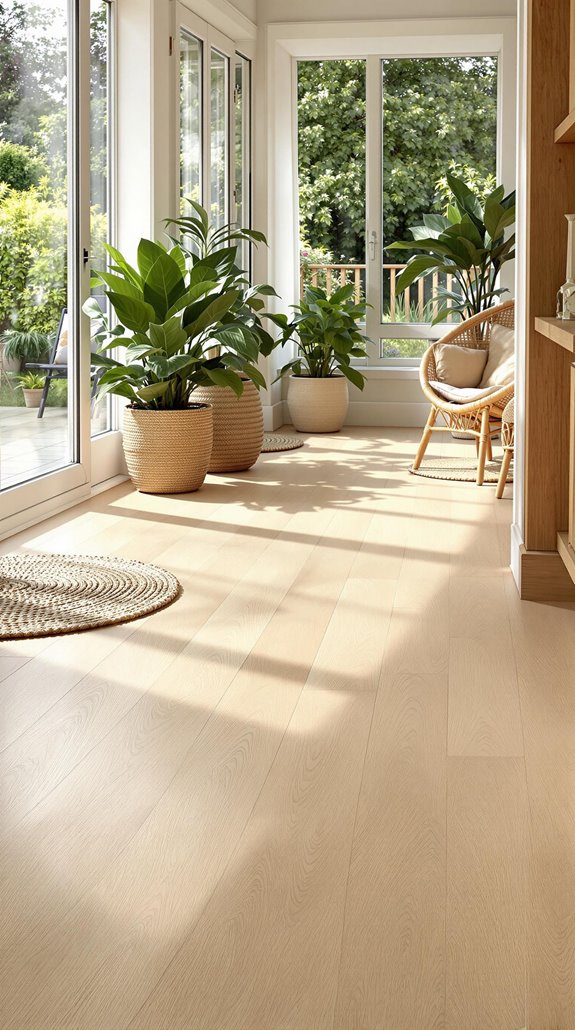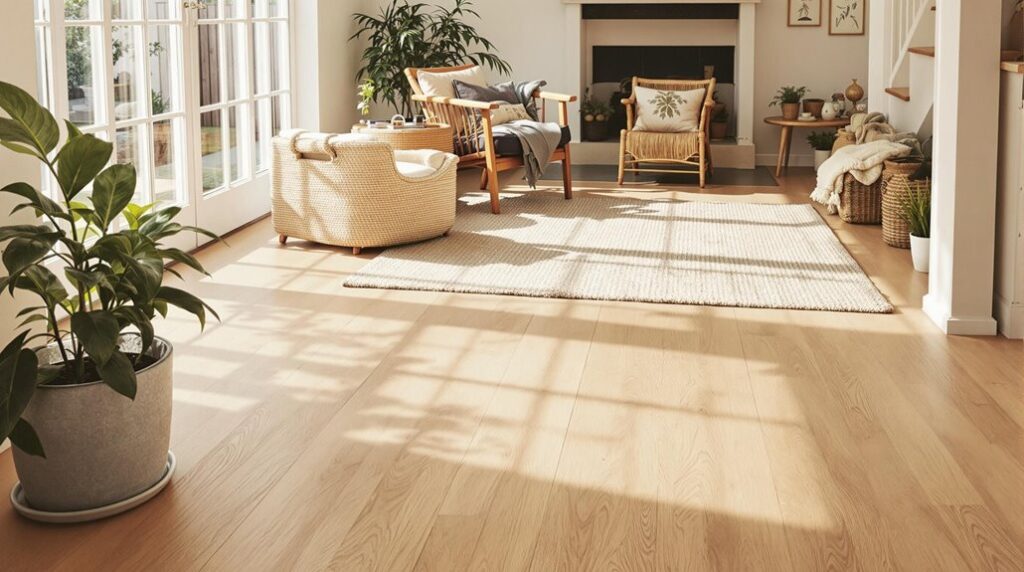I’ve installed flooring in dozens of UK summerhouses, and I can tell you that your choice will make or break your retreat’s functionality. Most homeowners focus solely on aesthetics, then face costly repairs when moisture penetrates their beautiful but unsuitable materials. You’ll need to understand which construction methods work with our climate and which flooring types actually withstand seasonal temperature swings. There’s a specific approach that prevents the three most common failure points.
Key Takeaways
- Engineered oak flooring offers timeless elegance and durability, complementing both traditional and contemporary summerhouse designs while providing superior humidity resistance.
- Vinyl flooring delivers exceptional waterproofing capabilities with wood-look finishes, making it ideal for moisture-prone areas without sacrificing natural aesthetic appeal.
- Ceramic tiles provide outstanding durability and water resistance, lasting 15+ years with minimal maintenance while offering excellent underfloor heating compatibility.
- Choose flooring thickness of 15-20mm for heavy-use areas, with pressure-treated materials essential for moisture protection and structural integrity.
- Match wood-tone flooring to exterior cladding or select neutral vinyl shades to create visual continuity and enhance perceived space in compact structures.
Essential Construction Materials for Summerhouse Flooring

When building a summerhouse, selecting the right flooring materials determines both structural integrity and long-term performance. I’ll guide you through the essential base materials that form your flooring foundation.
Tongue-and-groove panels serve as your primary substrate, creating the structural backbone you’ll rely on. I recommend using minimum 11mm thickness for basic applications, though I’d suggest upgrading to 15-20mm panels for areas expecting heavy use. This isn’t where you’ll want to cut corners.
For enhanced moisture protection, I prefer pressure-treated plywood as your base layer. It’s specifically engineered to handle the humidity challenges summerhouses face. If you’re environmentally conscious like many of us builders, reclaimed timber offers an excellent sustainable foundation option while maintaining the structural integrity you need.
Your flooring choice significantly impacts the overall aesthetic appeal of your summerhouse retreat, complementing both interior design elements and the surrounding outdoor environment.
Top Flooring Options for UK Garden Retreats
After establishing your structural foundation, you’ll need to choose from five primary flooring materials that perform reliably in UK garden retreats.
Engineered Wood Flooring
- Recommended minimum 15-20mm thickness for superior durability and sturdiness
- High-quality finish mimicking natural oak with enhanced longevity
- Natural warm aesthetic creating cosy and inviting interior atmospheres
- Compatible with underfloor heating systems for year-round comfort
- Simple maintenance requiring only regular sweeping and occasional mopping
Hardwood Flooring
- Ideal for garden offices, guest rooms, or creative studio spaces
- Offers timeless elegance with authentic natural wood beauty
- Highly durable construction withstanding decades of proper use
- Refinishable surface allowing multiple restoration cycles
- Premium investment adding significant long-term property value
- Wood floors may react to moisture changes affecting dimensional stability
Vinyl Flooring
- Versatile designs authentically mimicking wood or stone aesthetics
- Exceptional durability resisting high-traffic wear and tear
- Effortless cleaning with simple sweeping and damp mopping
- Full compatibility with underfloor heating installations
- Cost-effective solution delivering minimal maintenance requirements
Laminate Flooring
- Budget-friendly alternative to expensive solid wood options
- Extensive style range including realistic wood and stone effects
- Quick installation using efficient click-lock joining systems
- Limited moisture resistance compared to premium alternatives
- Non-refinishable surface showing inevitable wear over time
Tile Flooring
- Outstanding durability and complete water resistance for moisture-prone areas
- Available in porcelain, ceramic, or natural stone varieties
- Easy maintenance with non-porous, stain-resistant surfaces
- Excellent underfloor heating compatibility for maximum comfort
- Cool surface properties ideal for warm summer weather use
Weatherproof Solutions for Year-Round Use

While seasonal weather changes pose significant challenges to summerhouse flooring, selecting materials with superior moisture resistance and thermal stability guarantees your garden retreat remains functional throughout the year. I recommend prioritizing vinyl flooring and ceramic tiles for their exceptional weatherproof capabilities—both materials withstand freezing temperatures without cracking while maintaining slip-resistant surfaces during wet conditions. Furthermore, vinyl flooring offers easy maintenance and durability, making it a practical choice for outdoor spaces.
For those seeking natural aesthetics, engineered oak offers superior humidity resistance compared to solid hardwood, preventing warping during seasonal fluctuations. You’ll find that V313 standard boarded floors specifically designed for outdoor use provide unmatched durability against all weather elements.
Avoid chipboard and standard plywood entirely—these materials disintegrate when wet and compromise your investment. Instead, focus on pressure-treated timber or waterproof laminate variants that enable effortless cleanup after storms while maintaining structural integrity year-round. Modern woven vinyl options that mimic natural flooring provide an excellent alternative, offering waterproof properties with the aesthetic appeal of traditional materials.
Long-Term Performance and Care Requirements
Beyond selecting the right weatherproof materials, you’ll need to understand how each flooring type performs over decades of use and what maintenance protocols maximize your investment. I’ve found that LVP delivers 10-20 years of reliable service with weekly sweeping and monthly pH-neutral cleaning. Ceramic tiles excel with 15+ year lifespans when you reseal grout every three years using mildew-resistant products. Additionally, considering thermal efficiency in your summerhouse can further enhance comfort and reduce energy costs.
For engineered hardwood, annual wood-specific protectant applications shield against UV damage while maintaining that 7-15 year performance window. You’ll want to install underfloor ventilation systems and maintain humidity below 55% using dehumidifiers. Protective entry mats extend surface finishes by 30%, while quarterly timber inspections catch gaps before they compromise structural integrity. Proper tongue and groove boards made from solid timber provide the most reliable foundation for long-term durability in outdoor garden buildings. These proactive measures guarantee your flooring investment performs effectively throughout its service life.
Unsuitable Materials That Risk Structural Damage
When selecting flooring for your summerhouse, certain materials pose significant structural risks that can compromise your building’s integrity and drain your budget through costly repairs. I’d strongly advise against untreated hardwood, which expands and contracts with moisture changes, causing warping and creating gaps that invite rot. Water-prone materials like low-density laminate swell when exposed to dampness, particularly problematic since water damage represents the UK’s top insurance claim category. Heavy options such as thick stone or concrete can stress foundations, risking subsidence on unstable soils—a costly issue requiring underpinning at £1,200-£5,000+ per meter. Non-breathable surfaces like sealed vinyl trap moisture underneath, promoting mould growth and timber decay that affects millions of UK households annually. In regions with fluctuating temperatures, materials susceptible to freeze-thaw cycles can crack and deteriorate rapidly, compromising your summerhouse’s structural stability.
Balancing Style With Practical Functionality
After identifying materials that can damage your summerhouse structure, you’ll need flooring that delivers both visual appeal and robust performance. I recommend engineered oak for its classic appeal and durability—it complements both traditional log cabins and contemporary designs while outperforming laminate in longevity. For moisture-prone areas, vinyl’s waterproofing capabilities excel, offering wood-look finishes that replicate natural textures without water damage risks. Additionally, proper insulation techniques can help maintain a comfortable temperature within your summerhouse, enhancing your enjoyment of the space.
Match your wood-tone flooring to the summerhouse’s exterior for visual continuity. If you’re planning year-round occupancy, prioritize water-resistant options like vinyl for muddy footprints and spills. Workshop spaces benefit from scratch-resistant tile or thick engineered hardwood, while reading retreats need warmer vinyl finishes. Use neutral vinyl shades to create spacious illusions in compact structures. Consider adding floor insulation to enhance energy efficiency and reduce your carbon footprint throughout the year.
Conclusion

I’ve covered the essential materials and weatherproof solutions you’ll need for your summerhouse flooring project. You’ll want to prioritize moisture resistance and structural integrity when selecting materials. Don’t overlook the importance of proper subfloor preparation and ventilation systems. Remember, you’re investing in long-term performance, so choose quality materials that’ll withstand UK weather conditions. Focus on functionality first, then add style elements that complement your retreat’s purpose and design requirements.
References
- https://www.homebuilding.co.uk/ideas/summer-house-flooring-ideas
- https://tekaflooring.co.uk/blog/summerhouse-flooring/
- https://planetpropertyblog.co.uk/20-stunning-summer-house-flooring-ideas/
- https://www.leisurebuildings.com/how-to-guides/how-to-guide-choosing-a-shed-workshop-summer-house-log-cabin-floor/
- https://henleygardenbuildings.co.uk/the-best-garden-buildings-flooring-options/
- https://summerhouse24.co.uk/best-summer-house-flooring-options-for-2020/
- https://posh.co.uk/living/how-to-build-a-summerhouse/
- https://www.gardenroomsolutionsltd.co.uk/news/exploring-your-garden-room-flooring-options/
- https://ovaeda.com/blogs/articles/types-of-garden-flooring
- https://www.unnaturalflooring.com/articles/ultimate-summer-house-flooring/

